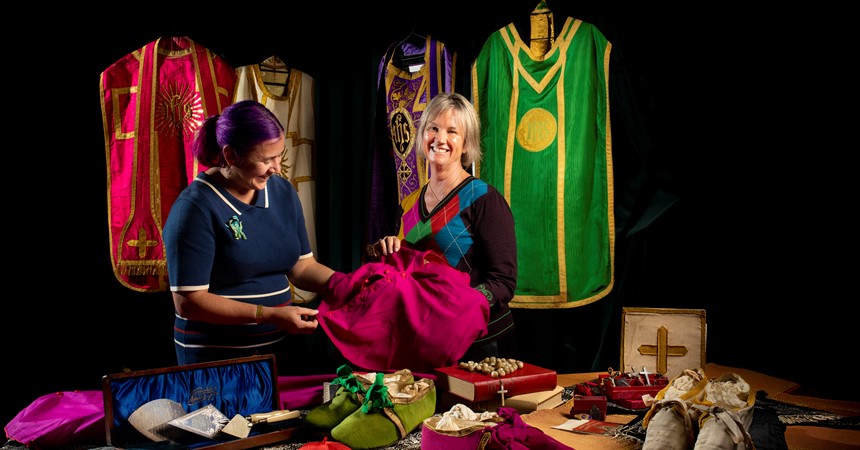These collections from yesteryear not only preserve the past; they also inform the future. Archives provide an entirely unbiased view of the social, cultural, and professional history of an institution. They are a collection of pure primary records of the events at the time they happened.
Church collections carry great significance and Canon Law prescribes each diocese must keep an archive: “In each curia there is to be established in a safe place a diocesan archive where documents and writings concerning both the spiritual and the temporal affairs of the diocese are to be properly filed.” (Canon 486)
The scope of Church activities is vast, ranging from education and childcare to social services, alongside the pastoral work conducted day to day. Archives is the diocesan repository that enables access to this valuable history, especially the when and how of decision making.
Archives at Cathedral House and within parishes record significant events for individuals and the community. Sacramental registers record the milestones of a person’s religious life, and bulletins and newsletters record the weekly goings-on of the parish. Large-scale events such as an Episcopal Congress and World Youth Day are recorded through official documentation, programs, and souvenirs.
In recording the past, archives display the evolving nature of the Church. Part of this is in the media the Church attracts. Tracking what the Church chooses to highlight and advertise in the pages of its publications from the Almanac of the Diocese of Maitland to The Newcastle and Maitland Catholic Sentinel and Aurora reflects the changes in attitudes of not only the Church but society at large.
Objects within the archives can visually show the evolving nature of the Church, particularly relating to pre and post Vatican II. Architectural plans and photographs show changes in the design and decoration of churches. Vestments, in particular chasubles, show the liturgical renewal of Vatican II through removing the more decorative elements and replacing them with a simpler “noble beauty” (SC 124).
Online advancements have added to the way we record and share our archives, but they haven’t changed the fundamentals of how we archive. Electronic registers allow the inclusion of an image of the object and greater ability to track the movement of objects. The information captured for each item is crucial to establishing provenance and adds to the historical and cultural value.
Advancements in online environments have also notably improved accessibility to archives. Many institutions may have archives they would like to share with the public, but due to space limitations are unable to offer access through a permanent or temporary exhibit. The use of digital galleries allows archives to be curated and widely shared in a dynamic way. The Diocese of Maitland-Newcastle does not have this feature but it is something the Archives and Research team are aiming for.
The Diocese’s records go back to the mid-1800s with our earliest correspondence from Bishop Murray. Some of my favourite items are the collection of rosary beads we hold. The variety in material, style, and cases they come in makes them a beautiful mini collection. I marvel also at the embroidery and lacework on the vestments we have in the archives. They are wonderful examples of the workmanship found in this artform of yesteryear.
Also of note are oil paintings of bishops Murray, Dwyer, Gleeson and Toohey, which hang in Cathedral House. Last year we received a request from the Art Gallery of NSW for information on any portraits in our collection that may have been contenders in the Archibald Prize. In researching this request, we found that the portrait of Bishop Gleeson was a finalist in the 1949 Archibald Prize.
Each month my colleagues and I curate a small display of items from the archives and make them available for the public to view at our diocesan offices in Hunter Street. As we carefully select each item I often wonder if the Archives and Research team still exists in 100 years from now, what would they select to showcase for this period? Of course, as a society sometimes we don’t realise the value of an object or event until we’re deep in the moment. It’s my absolute honour to ensure milestones and cultural objects, ranging from seemingly insignificant (now) to the extraordinary, are preserved for future generations. You never know, one of our students featured in Aurora could go on to be the next pope. How wonderful it would be to reflect on the documentation of their experience in our Diocese and ponder how it shaped their journey to the Vatican.
Karen Stitt is Team Leader, Archives and Research in the Diocese of Maitland-Newcastle.






















































































